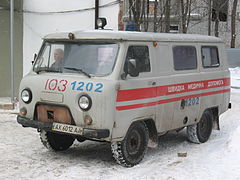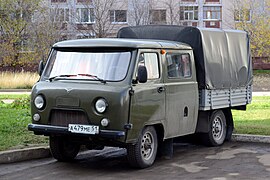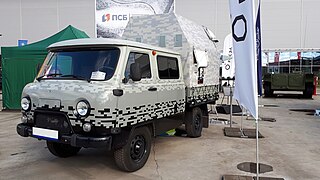This article needs additional citations for verification. (September 2011) |
| UAZ-452 (УАЗ-452) | |
|---|---|
 UAZ-3741 (1985) | |
| Overview | |
| Manufacturer | Ulyanovsk Automobile Plant |
| Also called |
|
| Production |
|
| Body and chassis | |
| Class | Off-road capable vans |
| Layout | Front-engine, four-wheel drive |
| Powertrain | |
| Engine | 2445 cc UMZ-452 petrol I4 |
| Dimensions | |
| Wheelbase | 2300 mm / 2550 mm (33036 trucks) |
| Length | 4440 mm / 4535 mm (33036 trucks) |
| Width | 1940 mm |
| Height | 2090 mm / 2355 mm (33036 trucks) |
| Kerb weight | 1,760 kg |
| Chronology | |
| Predecessor | UAZ-450 |
The UAZ-452 is a family of four wheel drive off-road vans and light trucks with body-on-frame construction and cab over engine design, built by the Ulyanovsk Automobile Plant (UAZ) since 1965. Originally designed for the Soviet military, since 1985 the vans received updates: more modern engines and internationally compliant lighting, as well as new model numbers, UAZ-3741 for the standard van, while (crew-cab) trucks mostly starting with UAZ-3303, often with one or two extra digits specifying the version. From 1997, bigger UAZ-33036 truck variants with a 25 cm (10 in) longer wheelbase, and taller soft-top roof bows and drop-sides were added.
Overview
[edit]


The model's predecessor, the UAZ-450 (produced between 1958 and 1966), was based on the chassis and engine of the four-wheel drive light truck GAZ-69, and was the first "forward control" vehicle of this type to be built in Russia or anywhere else in the Soviet Union.[1] The UAZ-450 was lightly revised and simplified, resulting in the UAZ-452.[2] Because of the external similarities to a loaf of bread, the van became known as Буханка (bukhanka, or 'loaf' in Russian). The ambulance version was nicknamed Таблетка (tabletka, a pill).[citation needed] The van is produced in several modifications, with the main difference being the body type (e.g. UAZ-3741 van (known as bukhanka), or the UAZ-3303 pickup truck, which is known as golovastik, tadpole).[citation needed]
The body of the van is normally equipped with two front doors, a single-wing door on the right side and a double-wing door at the rear, although the exact configuration can vary depending on the specific modification. Notable in the van are the fuel ports on the left and the right side of the van, leading to two separate fuel tanks.[3]
The engine, placed between the driver and the passenger seats, was the same 75 hp (55 kW) 2.4-litre (2,445 cc) UMZ-452MI inline-four as the UAZ-469, and was able to run on gasoline of as low as 72 octane (76 was preferred).[4]
History
[edit]Vehicles produced between 1965 and 1979 were equipped with old-style lights: turn signal lights were colorless (white), rear lights were round, and the back of the body was rounder. Subsequent post-1979 models got amber (yellow) signal lights, and rear lights were slightly bigger and rectangular.[citation needed]
In 1985 the van was upgraded and spun off into separate submodels: UAZ-39625, UAZ-3962, UAZ-3303, UAZ-3909 and UAZ-2206. The upgrade consisted of lighting fixtures that met modern international requirements, alarms, a new instrument panel, and a new speedometer. The brakes were redesigned. The engine was also upgraded, and its power output increased to 99 hp against the previous 78 hp.
In the early 2000s, the model was given new plastic side mirrors taken from the GAZ GAZelle van, headrests on front seats; and new passenger seats for a minibus version (UAZ-2206) were also given headrests. The pickup truck (UAZ-3303) was fitted with a metal body instead of a wooden one.
In subsequent years, the engine was upgraded to meet modern emissions requirements, and the van was also fitted with an injury-reducing plastic steering wheel.
In March 2011, models UAZ-39625, UAZ-3962, and UAZ-2206 received upgrades, consisting of ABS brakes, power steering, seat belts and the Euro-4 engine as standard equipment.
As of 2024 it is the oldest vehicle design in production.[5]
During the Russian invasion of Ukraine mounting losses of supply and utility vehicles in the Russian military faster than they could be replaced resulted in UAZ-452 loaf vans being deployed to the frontlines. Despite some rugged off-road features, its lack of shock absorbers, poor comfort and weak engine made its performance extremely poor and an easy target for drones. Its thin steel panels does not provide protection against drone strikes and fuel tanks are placed under the vehicle on both flanks makes its susceptible to catching fire. By 2024 destroyed Bukhankas became a common sight in Ukraine and as a result, Russian troops have attempted to reinforce the vans with caged armour. [6][7]
Former
[edit]UAZ-452 variants:
- UAZ-452 – van, the main version
- UAZ-452A – ambulance, called Санитарка (Sanitarka, "female paramedic"), popularly nicknamed the Таблетка (Tabletka, "tablet" or "pill"). The van can seat up to 4 stretchers or 6 on the benches and one accompanying both. The vehicle is not comfortable for people on the move, as suspension in the submodel remained that of the standard model, but this van was, and in many places is still the only ambulance vehicle that can reach some of the most remote places.[8]
- UAZ-452AS – ambulance for arctic areas
- UAZ-452AE – chassis cab for installation of various equipment
- UAZ-452V – convertible van wagon
- UAZ-452D – truck with double cab and wooden body (cutaway-van chassis)
- UAZ-452DG – experimental 6×6 version
- UAZ-452G – ambulance with different capacity from the UAZ-452A
- UAZ-452K – experimental 16-seater three-axle bus (6×4) (1973)
- UAZ-452P – tractor
Current
[edit]List of current UAZ-452 models:[9]
- UAZ-2206 – 6 to 11 seat minibus
- UAZ–22069 – a modification of the UAZ-2206 with a 98-horsepower engine UMZ-4218.10, increasing to 2.9 liters volume. Rough terrain buses provide permanent all-wheel drive and increased ground clearance. Maximum speed of 110–125 km/h.
- UAZ-3303 (UAZ-452D) Голова́стик Golovastik ('tadpole') – pickup truck with a 2-person all-metal cab
- UAZ-3741 – all-metal cargo van capable of carrying loads up to 850 kg
- UAZ-3909 – Фермер ("Farmer"), Combi which carries 6 passengers and 450 kg of cargo; the rear compartment is separated from the front (driver's) row with a window.
- UAZ-3909i – military ambulance with a red cross on the roof and bonnet
- UAZ-3962 – Tabletka ("Tablet") ambulance, can accommodate up to 9 people or equivalent load.
- UAZ-39625 – strict passenger and cargo version of the UAZ-3962. Differs from the 3909 version in the fact that the 3909 version has real and stationary passenger seats, and a separate not glassed-in cargo compartment behind the passenger compartment; and a fully glazed version 39625 has seats installed in the cargo hold, and the sides have a hinged bench.
- UAZ-39094 – crewcab pickup truck with a 10 cm metal platform with a wooden floor equipped with a removable frame tent and awning, 3 dropsides. Cargo bed replaceable by utility and special service bodies.
Users
[edit]This article needs additional citations for verification. (January 2023) |
 Armenia[10]
Armenia[10] Azerbaijan[11]
Azerbaijan[11] Belarus
Belarus Bulgaria
Bulgaria Cambodia[12]
Cambodia[12] Cuba
Cuba Egypt[12]
Egypt[12] Georgia
Georgia Hungary
Hungary Kyrgyzstan
Kyrgyzstan Moldova[13]
Moldova[13] Mongolia
Mongolia Netherlands
Netherlands North Korea[14]
North Korea[14] Russia
Russia Serbia
Serbia Syria
Syria Vietnam
Vietnam Ukraine[15]
Ukraine[15]
Specifications
[edit]| UAZ-3303 | UAZ-3741 | UAZ-2206 | UAZ-3962 | UAZ-3909 | UAZ-39094 | |
|---|---|---|---|---|---|---|
| Number of seats | 2 | 2 | 8-11 | 8 | 7 | 5 |
| Number of doors | 2 | 4 | 4 | 4 | 4 | 3 |
| Length, mm (ft) | 4474
(14’ 8") |
4440
(14’ 6") |
4440
(14’ 6") |
4440
(14’ 6") |
4440
(14’ 6") |
4847
(15’ 10") |
| Width, mm (ft) | 2100 | 2100 | 2100 | 2100 | 2100 | 2100 |
| Height, mm (ft) | 2355 | 2101 | 2101 | 2101 | 2101 | 2355 |
| Wheelbase, mm (ft) | 2550 | 2300 | 2300 | 2300 | 2300 | 2550 |
| Clearance, mm (ft) | 220 | 220 | 220 | 220 | 220 | 220 |
| Fording depth, mm (ft) | 500 | 500 | 500 | 500 | 500 | 500 |
| Curb weight, kg | 1845 | 1805 | 1940 | 1805 | 1905 | 1995 |
| Gross weight, kg | 3070 | 2730 | 2790 | 2730 | 2830 | 3070 |
| Payload, kg | 1225 | 925 | 850 | 925 | 925 | 1075 |
| Fuel | petrol (gas) | petrol (gas) | petrol (gas) | petrol (gas) | petrol (gas) | petrol (gas) |
| Engine displacement in liters. | 2,7 | 2,7 | 2,7 | 2,7 | 2,7 | 2,7 |
| Maximum power, hp (kW) | 112 (82.5) at 4000 rev / min | 112 (82.5) at 4000 rev / min | 112 (82.5) at 4000 rev / min | 112 (82.5) at 4000 rev / min | 112 (82.5) at 4000 rev / min | 112 (82.5) at 4000 rev / min |
| Maximum torque, Nm | 208 at 3000 rev / min | 208 at 3000 rev / min | 208 at 3000 rev / min | 208 at 3000 rev / min | 208 at 3000 rev / min | 208 at 3000 rev / min |
| Maximum speed, km / h (m/h) | 115 | 127 | 127 | 127 | 127 | 127 |
| Fuel consumption at 90 km / h, l / 100 km | 15,4 | 13,5 | 13,5 | 13,5 | 13,5 | 17 |
| Capacity fuel tanks, l | 50 | 77 | 77 | 77 | 77 | 50 |
| Gearbox | Manual, 5-speed | Manual, 5-speed | Manual, 5-speed | Manual, 5-speed | Manual, 5-speed | Manual, 5-speed |
| Transfer case | 2-speed | 2-speed | 2-speed | 2-speed | 2-speed | 2-speed |
| Brakes | dual circuit, vacuum booster, drum | dual circuit, vacuum booster, drum | dual circuit, vacuum booster, drum | dual circuit, vacuum booster, drum | dual circuit, vacuum booster, drum | dual circuit, vacuum booster, drum |
| Tyres | 225 / 75 R 16 | 225 / 75 R 16 | 225 / 75 R 16 | 225 / 75 R 16 | 225 / 75 R 16 | 225 / 75 R 16 |
Gallery
[edit]-
UAZ-2206
-
UAZ-3303
-
UAZ 452 van
-
UAZ-3909 Emergency Gas Service
-
UAZ-3962
-
"Sanitarka" UAZ-3962 all-wheel drive van common in rural areas of Russia
-
UAZ-39625
-
UAZ-39094
-
UAV counteraction complex "Ataka-Trophy" on UAZ-39094 chassis
-
Militsiya vehicle
-
UAZ-33036
See also
[edit]- Dodge A100
- Ford Econoline 1 (1961–1967)
- Volkswagen Type 2 ("Microbus")
- Mitsubishi Delica 1968
- GMC G1000 (Chevrolet Van) 1965
- RAF-977
- Daihatsu Hijet 1960
- Mazda Bongo 1966
- Renault Estafette
- Barkas B 1000
- Jeep Forward Control
Bibliography
[edit]- Ambulance Vehicle UAZ-452-A // "Soviet Military Review", No. 8, August 1988. page 27
- Foss, Christopher F.; Gander, Terry J., eds. (1999). Jane's Military Vehicles and Logistics 1999-2000 (20th ed.). Janes Information Group. ISBN 978-0-7106-1912-9.
References
[edit]This article has been brought over from the Russian Wikipedia article.
- ^ "Уазбука. Галерея автомобилей УАЗ-450".
- ^ "Russian UAZ just came up with the toughest overlander van". Hagerty Media. 5 February 2020. Retrieved 26 October 2020.
- ^ "Parts Catalogue" (PDF). uaz.rustina.cz. p. 53.
- ^ Thompson, Andy. Cars of the Soviet Union (Haynes Publishing, Somerset, UK, 2008), p.178.
- ^ "UAZ Bukhanka 2024 prices, models, configurations, photos, new body, video".
- ^ Day, Lewin (7 June 2024). "Oldest Vehicle Still In Production Becomes Key To Russia's War Effort". The Autopian. Retrieved 22 October 2024.
- ^ Rumble, Stuart (10 June 2024). "Soviet-era Loaf van becomes Russia's main battlefield resupply vehicle in Ukraine". www.forcesnews.com. Retrieved 22 October 2024.
- ^ Де Агостини Автолегенды СССР [1] (Avtolegendy USSR). УАЗ-452 Moscow ISSN 2071-095X
- ^ "Открытое Акционерное Общество 'Ульяновский автомобильный завод'". Archived from the original on 15 June 2009. Retrieved 8 June 2009.
- ^ "Arminfo: A military off-road vehicle crashes into a residential house in Armenia killing one and wounding two". arminfo.info. 27 June 2014. Retrieved 3 January 2024.
- ^ Janovsky, Jakub; Dan; Mitzer, Stijn; Oliemans, Joost; Kemal (27 September 2020). "The Fight For Nagorno-Karabakh: Documenting Losses On The Sides Of Armenia And Azerbaijan". Oryx. Retrieved 3 January 2024.
- ^ a b Foss & Gander 1999, p. 307.
- ^ "English: A Moldova ambulance at the Bulboaca Training Center in Moldova". 8 August 2007.
- ^ "Pyongyang Medical College Hospital. | Download Scientific Diagram".
- ^ "Bogdan Corporation hands over some 50 upgraded Bogdan 2251 ambulance vehicles to Armed Forces in Aug". Interfax-Ukraine. 10 September 2018. Retrieved 3 January 2024.












